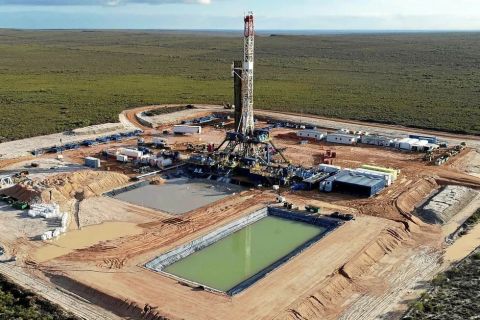U.S. natural gas futures were little changed on Oct. 27 as the market waited for direction from a federal report expected to show a smaller than usual storage build last week when colder than normal weather boosted heating demand.
That lack of price movement also came on the last day the November contract will be the front-month on the New York Mercantile Exchange, which has traditionally been a day of low volume and extreme volatility.
Analysts forecast U.S. utilities added 59 Bcf of gas to storage during the week ended Oct. 21. That compares with an increase of 88 Bcf in the same week last year and a five-year (2017-2021) average increase of 66 Bcf.
If correct, last week's increase would push stockpiles to 3.401 Tcf, or 5.3% below the five-year average of 3.591 Tcf for this time of the year.
Other factors affecting trade on Oct. 27 include bearish forecasts for milder weather and lower demand next week than previously expected, and output holding near record levels for the month.
On the bullish side, a couple of LNG export terminals were expected to exit outages soon, which will boost overall demand for gas.
Major LNG outages include Berkshire Hathaway Energy's shutdown of its 0.8 Bcf/d Cove Point LNG export plant in Maryland on Oct. 1 for a few weeks of planned maintenance, and the shutdown of Freeport LNG's 2.0 Bcf/d plant in Texas for unplanned work after an explosion on June 8.
Freeport expects the facility to return to at least partial service in early- to mid-November.
At least three vessels were heading to Freeport, Refinitiv data showed. Prism Brilliance was off the coast from the plant, Prism Diversity was expected to arrive Oct. 28 and Prism Courage on Nov. 1.
While some traders expect Freeport to delay its return to service, company officials have said the plant remains on track to return in November.
On its last day as the front-month, gas futures for November delivery fell 2.1 cents, or 0.4%, to $5.585/MMBtu at 7:47 a.m. EDT.
Futures for December, which will soon be the front-month, were trading around $6.03 per MMBtu.
In the spot market, gas prices at the Waha hub in the Permian Basin in West Texas fell into negative territory in intraday trade this week as pipeline maintenance prevented some gas from leaving the basin.
Waha prices closed at a positive 1 cent per MMBtu for Oct. 27, their lowest since settling in negative territory in October 2020 for a second day in a row.
U.S. gas futures are up about 49% so far this year as soaring global gas prices feed demand for U.S. exports due to supply disruptions and sanctions linked to Russia's Feb. 24 invasion of Ukraine.
Gas was trading at $32/MMBtu at the Dutch Title Transfer Facility (TTF) in Europe and $30 at the Japan Korea Marker in Asia.
Earlier this week, European forwards fell to $27/MMBtu, their lowest close since June 13, as mild weather and strong LNG imports allowed utilities to boost the amount of gas in storage in northwest Europe to more than 90% of capacity. That put TTF down about 70% since settling at a record $90.91 in August.
Data provider Refinitiv said average gas output in the U.S. Lower 48 states held at 99.4 Bcf/d so far in October, tying the monthly record in September.
With seasonally cooler weather coming, Refinitiv projected average U.S. gas demand, including exports, would rise from 94.8 Bcf/d this week to 96.6 Bcf/d next week. The forecast for this week was higher than Refinitiv's outlook on Oct. 26, while its forecast for next week was lower.
Recommended Reading
Brett: Oil M&A Outlook is Strong, Even With Bifurcation in Valuations
2024-04-18 - Valuations across major basins are experiencing a very divergent bifurcation as value rushes back toward high-quality undeveloped properties.
Marketed: BKV Chelsea 214 Well Package in Marcellus Shale
2024-04-18 - BKV Chelsea has retained EnergyNet for the sale of a 214 non-operated well package in Bradford, Lycoming, Sullivan, Susquehanna, Tioga and Wyoming counties, Pennsylvania.
Triangle Energy, JV Set to Drill in North Perth Basin
2024-04-18 - The Booth-1 prospect is planned to be the first well in the joint venture’s —Triangle Energy, Strike Energy and New Zealand Oil and Gas — upcoming drilling campaign.
PGS, TGS Merger Clears Norwegian Authorities, UK Still Reviewing
2024-04-17 - Energy data companies PGS and TGS said their merger has received approval by Norwegian authorities and remains under review by the U.K. Competition Market Authority.
Energy Systems Group, PacificWest Solutions to Merge
2024-04-17 - Energy Systems Group and PacificWest Solutions are expanding their infrastructure and energy services offerings with the merger of the two companies.




